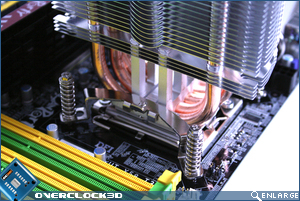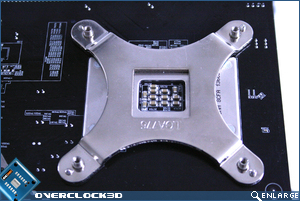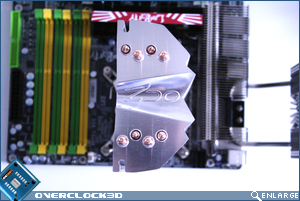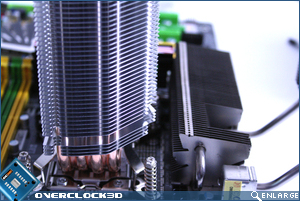OCZ Gladiator MAX CPU Cooler
Test Setup
To ensure all our CPU cooler tests are as equal as possible we intend to use the same base setup, CPU clockspeed and BIOS settings. We also take special consideration to ensure that the ambient temperature is as near to 23 degrees centigrade as possible throughout the testing thanks to an digitally controlled air conditioning system.
Intel Stock i7 920 skt 1336 cooler
Asus Triton 81 HSF
OCZ Gladiator Max
CPU: Intel Nehalem i7 920 Skt1366 2.66GHz
Motherboard: DFI X58 T3eH8
Memory: 3x2GB Corsair Dominator DDR3 1600mhz @ 8-8-8-24
HD : Hitachi Deskstar 7k160 7200rpm 80GB
GPU: Nvidia GTX280
Graphics Drivers: GeForce 180.60
PSU: Gigabyte ODIN 1200w
Â
Â
Testing Methodology
I will be testing the OCZ Gladiator Max on an Intel Core i7 920 processor to assess the heatsinks ability to handle the heat-load of a quad-core. Whilst I appreciate that the OCZ Gladiator Max is also compatible with lower end CPU’s, the Core i7 is renowned for being very toasty so should prove to be a very good test of the OCZ Gladiator Max’s cooling capabilities.
Ambient temperature will be taken using a standard mercury thermometer and allowing it time to normalise. Processor idle/load and overclocked temperatures will be obtained using Real Temp 2.70 with the TJmax set to 100c, Each core temperature will be recorded. All testing will be conducted 3 times and an average taken to ensure the uniformity of results. All of the heatsinks were removed, and then re-installed a total of three times to ensure the elimination of any poor mounting issues. Arctic Silver 5 will be used on all of the coolers to eliminate the influences TIM may have on temperatures.
The program we will use to put the CPU under highest load will be IntelBurn Test ver 1.60 by AgentGod:
Ambient temperatures during testing ranged from 22.8 – 23.4 degrees Celsius.
Testing for noise is very subjective and without the correct decibel measuring equipment that is calibrated professionally including any results would be pointless. I will point out though that the OCZ is significantly quieter than both the stock Intel cooler and the Asus Triton that we reviewed previously. This is not really surprising as the Gladiator Max takes advantage of its bigger size by utilising a 120mm fan which turns at less revolutions than the 92mm fan of the Triton.
With the formalities out of the way let’s crack on with the testing…






